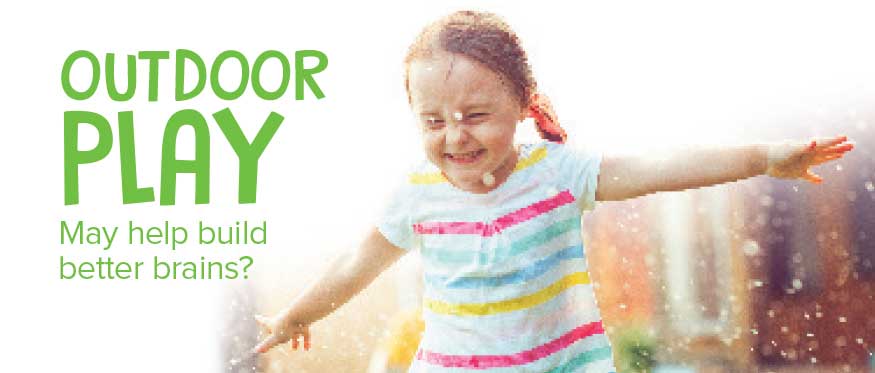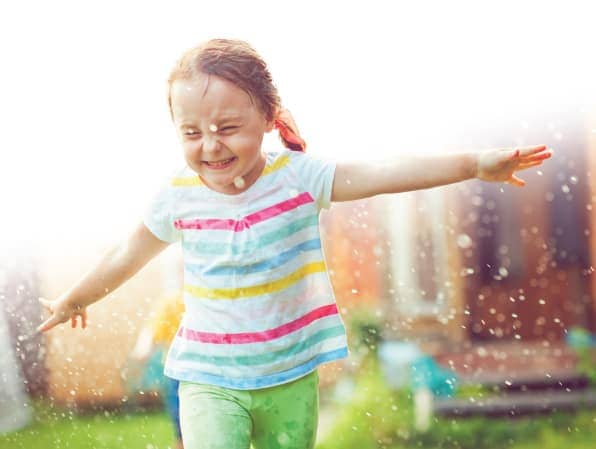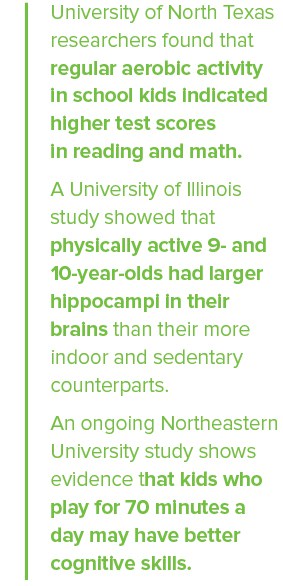

Those rosy cheeks. Those breathless reports of everything seen and done in the park, or maybe just in the backyard. And, yes, those sparkling eyes, which will soon close from the fatigue of a fun day spent outside.
To the list, we can add a bigger brain and improved brain function. And, enhanced creativity. All of these are the benefits kids enjoy by merely playing outside.
Could extra outdoor play translate to enhanced “smarts” in school and life? It certainly could and probably does! In a world where more and more school-aged children (and even plenty of preschoolers) get their play and entertainment delivered on a screen, it’s essential to know how superior outdoor play is:
The benefits of active play start with increased blood flow and enhanced oxygen delivery to the brain. But that’s not where they end. For example, Northeastern’s Charles Hillman says there appears to be a memory-enhancing benefit of play, as numbers of “neuro-protecting molecules” have been shown to rise during play. This last discovery perhaps explains why so many kids seem to absorb and retain information better when learning takes place with repetitive, even rhythmic, forms of activity – like shooting baskets, jumping on a trampoline, or skipping rope. Note that many of these are solitary activities which do not require a team membership or an organized sports event. Indeed, having time to daydream, which is getting increased recognition as a sign of intelligence, is a factor in the value of outdoor play.
Next time a child you love settles in to spend free time watching TV or playing on the computer, remember that science tells us that kids ages 6–17 should be getting at least an hour of moderate-to-vigorous activity each day. How about preschoolers? The experts say that the littlest ones shouldn’t stop being active until nap- or bedtime slows them down!
Those rosy cheeks. Those breathless reports of everything seen and done in the park, or maybe just in the backyard. And, yes, those sparkling eyes, which will soon close from the fatigue of a fun day spent outside.
Could extra outdoor play translate to enhanced “smarts” in school and life? It certainly could and probably does! In a world where more and more school-aged children (and even plenty of preschoolers) get their play and entertainment delivered on a screen, it’s essential to know how superior outdoor play is:
The benefits of active play start with increased blood flow and enhanced oxygen delivery to the brain. But that’s not where they end. For example, Northeastern’s Charles Hillman says there appears to be a memory-enhancing benefit of play, as numbers of “neuro-protecting molecules” have been shown to rise during play. This last discovery perhaps explains why so many kids seem to absorb and retain information better when learning takes place with repetitive, even rhythmic, forms of activity – like shooting baskets, jumping on a trampoline, or skipping rope. Note that many of these are solitary activities which do not require a team membership or an organized sports event. Indeed, having time to daydream, which is getting increased recognition as a sign of intelligence, is a factor in the value of outdoor play.
Next time a child you love settles in to spend free time watching TV or playing on the computer, remember that science tells us that kids ages 6–17 should be getting at least an hour of moderate-to-vigorous activity each day. How about preschoolers? The experts say that the littlest ones shouldn’t stop being active until nap- or bedtime slows them down!















